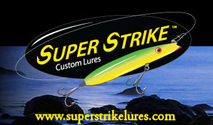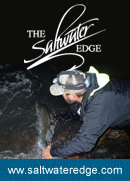
Release
by Dennis Zambrotta
An hour of casting plugs and eels into the teeth of a steady southwest breeze and I had not a touch. I was somewhat puzzled as these conditions were perfect for this location. Only 24 hours earlier I managed four bass to thirty pounds in the less than ideal conditions provided by a cold northeast wind. I kept one of those bass for the grill and noticed it was loaded with 3 inch sand eels and baby lobsters. With the wind going southwest and sand eels in the area I was ready for the big score at this location tonight – it didn’t happen. Such is the unpredictable nature of surfcasting for striped bass. Too early to quit and with four more hours of the ebb tide remaining I high-tailed it to another location some two miles distant. After a fifteen minute walk I was on a rocky perch with the southwest wind now blowing over my right shoulder. The nearly full moon did its best to brighten the night but was negated by a low level fog causing an eerie glow. The eel still attached to my hook since leaving my last perch showed a sign of life by curling just the last inch of its tail. First cast with it produced a solid strike and subsequent drop about twenty feet out. I quickly lobbed the eel into the same location and had an immediate take from a 15 pound bass that didn’t miss its second chance at dinner. Three casts later I felt the telltale “tap, tap, shake, shake” of a bluefish take. I retrieved steadily hoping the blue would drop the eel and it did, but only after taking 8 inches and leaving me with a 6 inch “cigar butt”. I’ve used cigar butts with great success in the past and continued to cast with the butt. To my surprise no other bluefish took the butt but I did get a few “grab and drops” from bass that were either finicky, small, or both. I was hoping just finicky…
Now somewhat confident there were no other bluefish in the vicinity I hooked up another fresh eel and cast into the fog. At the very end of a wind aided cast I had an immediate take on my eel. I set on the fish and watched the water erupt some 100 feet away. Judging by the splash I knew this was a “decent” bass. Not long after her first run against a very tight drag I knew the word “decent” didn’t do justice for describing this fish. It wasn’t until she stopped and I tried to recover line that I knew she had some serious heft. At that point I wanted badly to see this fish. My mind started to race as I began scanning the water for any lobster pot buoys I might need to dodge. The thought of the eel sliding up my running line as so often happens when hooked up to a large bass made me a bit nervous, this feeling justified by having lost two very large bass in recent years at this very location when bluefish chomped my eels thus severing my running line. Seconds turned to minutes as I tried to hurry her in. My first glimpse of her white belly reflecting the foggy moonlight provided a guess of 45-50. As bad luck would have it she swam to my right and into some submerged rocks instead of left into the shallow tide pool. These rocks were much tougher for landing fish and I slid down a steep barnacle covered boulder into two feet of water. I grabbed her with both hands and grunted while lifting and placing her on the rock perch above me. I removed the hook from her upper jaw and then dug into the surf bag for my 60 pound hand scale. I placed my rod alongside her and she measured out at approximately 50 inches, then hoisted her up and my scale read 53 pounds. I glanced around quickly to see if any other fishermen had witnessed the catch but not a soul was in sight at this late hour. I then hurried into the shallow water to revive her for release. It took about 10 minutes in waste deep water for her to regain strength and stay upright, all the while cold water seeped into new holes in the backside of my waders courtesy of my sliding on barnacles when trying to land her. I followed her into deeper water as she slowly swam away making sure she didn’t show signs of turning over. She began to pick up speed as I followed her progress with my neck-light. Then with a strong thrust of her tail she disappeared out of sight, but never out of memory.
Editorial – Some thoughts on Catch and Release
by Dennis Zambrotta
There has been lots of chatter about Catch and Release on striper sites and social media recently. This is very encouraging. It has taken a while but the surfcasting community finally seems to believe there is something wrong with the overall numbers of striped bass. But I caution readers that much of what you may read about C&R could very well be misinformation. Being an old school surfcaster who’s been around for a while I’ve been through this before during the striped bass swoon of the 1980s. Before then the only Catch and Release practiced was throwing back an undersized bass less than 16 inches. Everything else was kept and many were sent to the markets – that was the culture. When the striped bass biomass dropped to unsustainable levels many fishermen including I reformed our ways and would sell no more bass. The Catch and Release ethic caught on and picked up steam among the striper coast. My surfcasting crew lived in our own little world casting the mainland Rhode Island coastline. In 1985 we expanded our horizons to Block Island – why? Because the last of the buffalo (or striped bass in this case) were out there in phenomenal numbers….but existed almost nowhere else. Casting on Block’s SW bar one dark night we had a good pick of quality bass, suffice to say at the time a 20 pound bass was considered a Block Island schoolie. I was in the process of weighing and then releasing a very nice bass when two unknown casters came up to me from behind. Now you have to realize that Block was a magnate for rod and reel pinhooker’s at the time because you could easily make a grand during a week of fishing. This was the nature/culture of the surfcasting game at that time. Anyway, I was expecting to be harassed for letting $80 bucks go swimming free but to my surprise the two unknown anglers praised me and couldn’t believe that someone else besides them had started the C&R practice. We introduced ourselves – the unknown casters were Bradford Burns and his friend Fred Thurber. Yes, the same Brad Burns who is the founding member of Stripers Forever – it’s interesting to note that Brad has always been an advocate of C&R. We all became friends and were very involved in the striper wars which were raging at the time. As the numbers of striped bass dwindled C&R became very popular and it appeared that its practice would become the “norm” along the striper coast. But then came the 1990s and restrictions on striped bass were relaxed. Size and bag limits were increased and a new term came into vogue when discussing striped bass that has changed the way fishermen view the species – that word is “keeper”. From that point on any bass that was larger than the minimum size limit was considered a keeper – something to take home. It didn’t take the fishing public long to take advantage of the relaxed restrictions – fisherman would talk in terms of how they did – “took my two keepers last night” was a very common phrase. Some thought they were still practicing C&R by releasing smaller than keeper size bass…. but is releasing undersize bass or all bass AFTER you’ve already kept/killed two bass still considered C&R? It stretches the intent and definition of C&R for sure.
I’m often asked how I practice C&R and what I recommend. I have a fairly complex answer. I release all of the larger striped bass that I’m fortunate to catch. After all, larger bass don’t taste very good and they kill my back if I have to lug them to my vehicle. They also have the potential to add cow bass genes to the gene pool when released. For trophy bass my suggestion is to only keep a cow sized bass if it beats your personal best. This allows someone the flexibility of keeping a trophy. I can’t in my right mind give someone grief about keeping a fish they are proud of. The great thing about this method is it keeps raising your personal bar and becomes harder to do as you reach the 30, 40, 50, and if you’re fortunate, the 60 pound pinnacles. I’ve killed one bass over 50 in my lifetime and been very fortunate to have released three others. But what do you do when you want one for the table? This is when “selective harvest” comes into play. If my wife asks me for a bass for the grill I will target a just legal bass between 28 and 32 inches. They tend to taste the best at that size and still provide plenty of meat. Just remember “Limit your kill – don’t kill your limit.”
Does C&R make a difference? When you think of it being practiced up and down the striper coast it most definitely makes a difference. But all the practitioners of C&R do it their own way. Some anglers may even hang the bass they intend to release on, dare I say it, a boga grip or hand scale. Surfcasters should not bash these anglers because the spirit of what they’re doing is what matters here – they’re trying to make a difference. I mean which bass has a better chance to survive? A bass that is handled with a boga-grip and then released, or one that is placed into the bass coffin in back of your buggy? And before you start giving anyone a hard time about catching bass on a diamond jig because it’s “too easy” consider that in most cases this method uses a single hook vice a multi-hook trebled plug – diamond jigs are a very C&R friendly method. As surfcasters we may all practice C&R a little differently, some of us fish sand beaches, some rock perches, still others on jetties/bridges. Good practice and release skills such as limiting the time the bass is out of water, and avoiding gill invasion, will increase the chances of survival. Just remember – we’re not all perfect but the spirit of why we’re doing it is the most important aspect of C&R. Please respect that.
Dennis Zambrotta is well know Rhode Island surfcaster and friend of the Surfcaster’s Journal Magazine since our humble beginnings. He was fortunate to be one of the major players during the great Block Island Giant Striper Blitzes in 1980′s and he has recently wrote a book about his experience, Surfcasting Around the Block. A good read for any surfcaster.













thks. i enjoy your work
↓That is some sound C&R logic I can get behind!
↓Thanks for sharing Mr Zambrotta.
If all surfcasters would live by these kind of guidelines it would be such a blessing. I had a chance to talk with Dennis this weekend at SWE and it is always a pleasure. And one of the two guys from SWE I trust to spool my VS
↓Thanks Dennis
↓Thank you
↓Great post by a great writer, thank you.
↓Great Read…. Thank You
↓Great reading about the beginning of C&R. I also love C,P&R (catch , Photo, release). I too keep only one fish a year at 29″or slightly larger . I personally wish they would lower the size to 26″ for a fish with less Hazardous metals and such. But limit it to only one.
↓nice dennis
↓Great piece and perspective, Mr. Zambrotta. Now I know which book Iw ant to buy next. Thank you for passing the C&R ethic!
↓Great entry. That’s why I have read surfcasting the block several times, and keep it in my brief case as a back up for times when I am stuck waiting somewhere. That’s also why I cross the bridge to go to fish club, so I can interrogate DZ.
↓A nice read and great perspective on C & R. Thanks Dennis.
↓Great article Dennis! We are working out the details for a C&R tourney for my club. I prefer to use fork length but others want to use Boka type scales. Your opinion would be appreciated.
↓Necker – our club has a C&R catagory. To be eligible a bass needs to be weighed on a hand scale/boga and the weight witnessed by a person 16 years or older. We also have a C&R catagory for a fly rod division which eligible bass only need to be measured in inches – not weighed.
DZ
↓Thanks again Dennis.
↓Thanks Dennis enjoyed the article.
Z how about a line of surfcasters journal catch and release shirts,hoodies etc
I think they would sell
↓Thanks all for the kind words.
↓